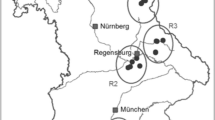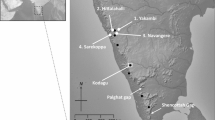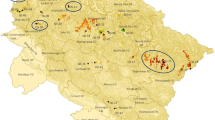Abstract
Vitellaria paradoxa C. F. Gaertn., commonly known as shea tree or Vitellaria, is ranked the most important tree species of the savannah regions in the most African countries due to its ecological and economic importance for livelihoods and national economies. However, the savannah regions are the most vulnerable areas to the global climate change. Moreover, the Vitellaria populations on farmlands are threatened by the dominance of old trees with low or lack of regeneration. In this study both morphological and genetic diversity were assessed using several phenotypic traits and 10 microsatellite markers, respectively, to assess the impact of land use and agro-ecozone types on Vitellaria in Ghana. The land use types were forests and farmlands, and the agro-ecozone types included the Transitional, Guinea, and Sudan savannah zones. The mean values of morphological traits, such as diameter at breast height (DBH) and canopy diameter (CD), were statistically different between forest (DBH = 22.20, CD = 5.37) and farmland (DBH = 39.85 CD = 7.49) populations (P < 0.00001). The Sudan savannah zone with mean petiole length of 4.96 cm showed significant difference from the other zones, likely as a result of adaptation to drier climate conditions. Genetic data analysis was based on 10 microsatellite markers and revealed high genetic diversity of Vitellaria in Ghana: mean expected heterozygosity, H e was 0.667, and allelic richness, measured as number of effective alleles A e , was 4.066. Both farmlands and forests were very diverse indicating lack of negative influence of farmer’s selection on genetic diversity. Fixation index was positive for all populations (mean F IS = 0.136) with farmlands recording relatively higher values than forests in all ecological zone types studied, probably indicating less gene flow in the farmlands. Moderate differentiation (F′ ST = 0.113) was comparable to other similar tree species. Both land use and ecological zone types influenced genetic differentiation of Vitellaria at varying levels. The species was spatially structured across three ecozones and following climatic gradient. The forest reserves are used in situ conservation for Vitellaria in Ghana. High diversity observed in the most arid zones provides opportunity to find and use appropriate plant materials for breeding climate change resilient trees.






Similar content being viewed by others
References
Akpona TJD, Akpona HA, Djossa BA, Savi MK, Daïnou KA, Ayihouenou B, Glèlè Kakaï R (2015) Impact of land use practices on traits and production of shea butter tree (Vitellaria paradoxa C. F. Gaertn.) in Pendjari Biosphere Reserve in Benin. Agrofor Syst 90:607–615. doi:10.1007/s10457-015-9847-1
Allal F, Vaillant A, Sanou H, Kelly B, Bouvet JM (2008) Isolation and characterization of new microsatellite markers in shea tree (Vitellaria paradoxa C. F. Gaertn.). Mol Ecol Resour 8:822–824
Allal F, Sanou H, Millet L, Vaillant A, Camus-Kulandaivelu L, Logossa Z, Bouvet JM (2011) Past climate changes explain the phylogeography of Vitellaria paradoxa over Africa. Heredity 107:174–186
Antoni F (2002) Applications of single nucleotide polymorphisms in crop genetics. Curr Opin Plant Biol 5(2):94–100
Bayala J, Ouedraogo SJ, Teklehaimanot Z (2008) Rejuvenating indigenous trees in agroforestry parkland systems for better fruit production using crown pruning. Agrofor Syst 72:187–194. doi:10.1007/s10457-007-9099-9
Bayala J, Sanou J, Teklehaimanot Z, Kalinganire A, Ouédraogo SJ (2014) Parklands for buffering climate risk and sustaining agricultural production in the Sahel of West Africa. Curr Opin Environ Sustain 6:28–34
Boffa JM (1999) Agroforestry parklands in sub-Saharan Africa. FAO conservation guide 34 Rome: FAO
Boffa JM, Yaméogo G, Nikiéma P, Knudson DM, Temu AB, Melnyk M, Vantomme P (1996) Shea nut (Vitellaria paradoxa) production and collection in agroforestry parklands of Burkina Faso. In: Proceedings of an international conference Domestication and commercialization of non-timber forest products in agroforestry system held in Nairobi (Kenya) 19–23 Feb 1996 FAO, Roma (Italia)
Botstein D, White R, Skolnick M, Davis R (1980) Construction of a genetic linkage map in man using restriction fragment length polymorphisms. Am J Hum Genet 32:314–333
Bouvet JM, Kelly B, Sanou H, Allal F (2008) Comparison of marker- and pedigree-based methods for estimating heritability in an agroforestry population of Vitellaria paradoxa C. F. Gaertn. (shea tree). Genet Resour Crop Evol 55:1291–1301
Cardi C, Vaillant A, Sanou H, Kelly B, Bouvet JM (2005) Characterization of microsatellite markers in the shea tree (Vitellaria paradoxa C. F. Gaertn.) in Mali. Mol Ecol Notes 5:524–526
Carette C, Malotaux M, van Leeuwen M, Tolkamp M (2009) Shea nut and butter in Ghana: opportunities and constraints for local processing. Report of the project on the opportunities of shea nuts for Northern Ghana, pp 1–88
Collevatti R, Grattapaglia D, Hay J (2001) Evidence for multiple lineages of Caryocar brasiliense populations in the Brazilian Cerrado based on the analysis of chloroplast DNA sequence and microsatellite haplotype variation. Mol Ecol 12:105–115
Djossa B, Fahr J, Wiegand T, Ayihouenou B, Kalko E, Sinsi B (2007) Land use impact on Vitellaria paradoxa C. F. Gaertn. stand structure and distribution patterns: a comparison of Biosphere Reserve of Pendjari in Atacora district in Benin. Agrofor Syst 72:205–220
Dutech C, Joly H, Jarne P (2004) Gene flow, historical population dynamics and genetic diversity within French Guianan populations of a rainforest tree species, Vouacapoua americana. Heredity 92:69–77
Earl D, von Holdt B (2012) STRUCTURE HARVESTER: a website and program for visualizing STRUCTURE output and implementing the Evanno method conservation. Genet Resour 4:359–361
Ekue M, Gailing O, Vornam B, Finkedey R (2011) Assessment of the domestication state of ackee (Blighia sapida KD Koenig) in Benin based on AFLP and microsatellite markers. Conserv Genet 12:475–489
Evanno G, Regnaut S, Goudet J (2005) Detecting the number of clusters of individuals using the software structure: a simulation study. Mol Ecol 14:2611–2620
FAO (Food and Agriculture Organization of the United Nations) (2010) Global forest resources assessment 2010
Fobil J (2002) Horizon solution site. http://www.solutions-siteorg/node/110
Fontaine C, Lovett P, Sanou H, Maley J, Bouvet J-M (2004) Genetic diversity of the shea tree (Vitellaria paradoxa C. F. Gaertn.), detected by RAPD and chloroplast microsatellite markers. Heredity 93:639–648
Gijsbers H, Kessler J, Knevel M (1994) Dynamics and natural regeneration of woody species in farmed parklands in the Sahel region (Province of Passore, Burkina Faso). For Ecol Manag 64:1–12
Gwali S, Vaillant A, Nakabonge G, Okullo JB, Eilu G, Muchugi A, Bouvet JM (2014) Genetic diversity in shea tree (Vitellaria paradoxa subspecies nilotica) ethno-varieties in Uganda assessed with microsatellite markers. For Trees Livelihoods 24:163–175. doi:10.1080/14728028.2014.956808
Hall J, Aebischer D, Tomlinson H, Osei-Amaning E, Hindle J (1996) Vitellaria paradoxa: a monograph Bangor: School of Agriculture and Forest Sciences publication number 8 University of Wales
Hamrick J, Godt M, Sherman-Broyles S (1992) Factors influencing levels of genetic diversity in woody plant species. New For 6:95–124
Hollingsworth P, Dawson I, Goodall-Copestake W, Richardson J, Weber J, Sotelo Montes C, Pennington R (2005) Do farmers reduce genetic diversity when they domesticate tropical trees? A case study from Amazonia. Mol Ecol 14:497–501
IUCN (1998) The IUCN red list of threatened species. http://www.iucnredlistorg/details/37083/0
John A, Melvin L, Susan C, Sophia C, Scott L, Fredrick A, Yaw A (2011) Ghana climate change vulnerability and adaptation assessment. Washington, DC: United States Agency for International Development (USAID)
Kelly B, Bouvet JM, Picard N (2004a) Size class distribution and spatial pattern of Vitellaria paradoxa in relation to farmers’ practices in Mali. Agrofor Syst 60:3–11
Kelly B, Hardy O, Bouvet JM (2004b) Temporal and spatial genetic structure in Vitellaria paradoxa (shea tree) in an agroforestry system in southern Mali. Mol Ecol 13:1231–1240
Kelly B, Gourlet F, Bouvet JM (2007) Impact of agroforestry practices on the flowering phenology of Vitellaria paradoxa in parklands in southern Mali. Agrofor Syst 71:67–75
Kimberly AS, Robert JT (2006) Microsatellites for ecologists: a practical guide to using and evaluating microsatellite markers. Ecol Lett 9:615–629
Lagossa Z, Camus-Kulandaivelu L, Allal F, Vaillant A, Sanou H, Kokou K, Bouvet JM (2011) Molecular data reveal isolation by distance and past population expansion for the shea tree (Vitellaria paradoxa C. F. Gaertn.) in West Africa. Mol Ecol 20:4009–4027
Langella O (1999) Populations version 1.2. 32. Distributed by the author, CNRS UPR9034, France
Lemes M, Gribel R, Proctor J, Grattapaglia D (2003) Population genetic structure of mahogany (Swietenia macrophylla King, Meliaceae) across the Brazilian Amazon, based on variation at microsatellite loci: implications for conservation. Mol Ecol 12:2875–2883
Lhuillier E, Butaud JF, Bouvet JM (2006) Extensive clonality and strong differentiation in the insular pacific tree Santalum insulare: implications for its conservation. Ann Bot 98:1061–1072
Lovett P, Haq N (2000a) Evidence for anthropic selection of the Shea nut tree (Vitellaria paradoxa). Agrofor Syst 48:273–288
Lovett P, Haq N (2000b) Diversity of the Sheanut tree (Vitellaria paradoxa C. F. Gaertn.) in Ghana. Genet Resour Crop Ev 47:293–304
Maranz S, Kpikpi W, Wiesman Z, Armelle De Saint S, Chapagain B (2003) Nutritional values and indigenous preferences for shea fruits (Vitellaria paradoxa C. F. Gaertn) in African agroforestry parklands. Econ Bot 58(4):588–600
Maranz S, Wiesman Z, Bisgaard J, Bianchi G (2004) Germplasm resources of Vitellaria paradoxa based on variations in fat composition across the species distribution range. Agrofor Syst 60:71–76
Masters E, Yidana J, Lovett P (2004) Reinforcing sound management through trade: shea tree products in Africa. Int J For For Ind Unasylva 55(219):46–52
Meirmans P, Hedrick P (2011) Assessing population structure: F ST and related measures. Mol Ecol Resour 11:5–18
Menczer K, Quaye E (2006) USAID/Ghana environmental threats and opportunities assessment (FAA 118/9 assessment) Accra: USAID
Minia Z (2008) Climate change scenario development. In Agyemang-Bonsu WK (ed) Ghana climate change impacts, vulnerability and adaptation assessments Accra: environmental protection agency, Ghana, pp 2–13
Moore S (2008) The role of Vitellaria paradoxa in poverty reduction and food security in the Upper East region of Ghana. Earth Environ 3:209–245
Morgante M, Olivieri AM (1993) PCR-amplified microsatellites as markers in plant genetics. Plant J 3(1):175–182
Muller F, Voccia M, Ba A, Bouvet J (2009) Genetic diversity and gene flow in a Caribbean tree Pterocarpus officinalis Jacq: a study based on chloroplast and nuclear microsatellites. Genetica 135:185–198
Nei M (1972) Genetic distance between populations. Am Nat 106:283–392
Neumann K, Kahlheber S, Uebel D (1998) Remains of woody plants from Saouga, a medieval west African village. Veg Hist Archaeobot 7:57–77
Okullo J, Hall J, Masters E (2003) Reproductive biology and breeding systems of Vitellaria paradoxa. In: Improved management of agroforestry parkland systems in Sub-Saharan Afria. EU/INCO project contract IC18-CT98-0261. University of Wales Bangor, Bangor, UK
Okullo J, Hall J, Obua J (2004) Leafing, flowering and fruiting of Vitellaria paradoxa subsp nilotica in savanna parklands in Uganda. Agrofor Syst 60:77–91
Oppong-Anane K (2006) Country pasture/forage resource profiles. Publishing Policy and Support Branch, Office of Knowledge Exchange, Research and Extensions, FAO, Rome
Owusu M (1994) A country study: Ghana. Library of Congress Publication, Washington
Peakall R, Smouse P (2012) GenAlEx 65: genetic analysis in Excel Population genetic software for teaching and research-an update. Bioinformatics 28:2537–2539
Pritchard J, Stephens M, Donnelly P (2000) Inference of population structure using multilocus genotype data. Genetics 155:945–959
Raebild A, Hansen U, Kambou S (2012) Regeneration of Vitellaria paradoxa and Parkia biglobosa in a parkland in Southern Burkina Faso. Agrofor Syst 85:443–453
Rajeev K, Andreas G, Mark E (2005) Genic microsatellite markers in plants: features and applications. Trends Biotechnol 23(1):48–55
Sanou H, Lamien N (2011) Vitellaria paradoxa, shea butter tree conservation and sustainable use of genetic resources of priority food tree species in sub-Saharan Africa Rome: Bioversity International
Sanou H, Lovett P, Bouvet JM (2005) Comparison of quantitative and molecular variation in agroforestry populations of the shea tree (Vitellaria paradoxa C. F. Gaertn.) in Mali. Mol Ecol 14:2601–2610
Sanou H, Picard N, Lovett P, Dembele M, Korbo A, Diarisso D, Bouvet J-M (2006) Phenotypic variation of agromorphological traits of the shea tree, Vitellaria paradoxa C. F. Gaertn., in Mali. Genet Resour Crop Evol 53:145–161
Schreckenberg K (1996) Forests, fields and markets: a study of indigenous tree products in the woody savannas of the Bassila region, Benin PhD thesis. University of London, London
Siaw D (2001) State of forest genetic resources in Ghana Rome: FAO, IPGRI/SAFORGEN, DFSC and ICRAF
Sneath P, Sokal R (1973) Numeric taxonomy: the principles and practice of numerical classification San Francisco: WH Freeman
Statistics, Research and Information Directorate (SRID) (2001) Agriculture in Ghana acts and figures. Ministry of Food and Agriculture Accra Ghana
Teklehaimanot Z (2004) Exploiting the potential of indigenous agroforestry trees: Parkia biglobosa and Vitellaria paradoxa in sub-Saharan Africa. Agrofor Syst 61:207–220
Tuffuor K (1996) National report on the Forestry Policy of Ghana. Forestry policies of selected countries in Africa FAO forestry paper 132
Ueno S, Setsuko S, Kawahara T, Yoshimaru H (2005) Genetic diversity and differentiation of the endangered Japanese endemic tree Magnolia stellata using nuclear and chloroplast microsatellite markers. Conserv Genet 6:563–574
Vos P, Hogers R, Bleeker M, Reijans M, Van de Lee T, Hornes M, Friters A, Pot J, Paleman J, Kuiper M, Zabeau M (1995) AFLP: a new technique for DNA fingerprinting. Nucleic Acids Res 23(21):4407–4414
Welsh J, McClelland M (1990) Fingerprinting genomes using PCR with arbitrary primers. Nucleic Acids Res 18:7213–7218
World Agroforestry Center (2016) Agroforestree database. http://www.worldagroforestry.org/treedb2/speciesprofile.php?Spid=394
Acknowledgments
We thank Alexandra Dolynska at the laboratory of Department of Forest Genetics and Tree Breeding, University of Goettingen Germany for the technical support with the laboratory analysis and Dr. E. A. Abeney of Kwame Nkrumah University of Science and Technolog Kumasi Ghana for his support during field work. This study was made possible by the financial support of the DAAD (Deutscher Akademischer Austauschdienst) through scholarship to the first author from Ghana.
Author information
Authors and Affiliations
Corresponding author
Ethics declarations
Conflict of interest
The authors have no conflict of interest to declare.
Ethical standards
The study complies with the current laws of Ghana, in which it was performed.
Rights and permissions
About this article
Cite this article
Abdulai, I., Krutovsky, K.V. & Finkeldey, R. Morphological and genetic diversity of shea tree (Vitellaria paradoxa) in the savannah regions of Ghana. Genet Resour Crop Evol 64, 1253–1268 (2017). https://doi.org/10.1007/s10722-016-0434-8
Received:
Accepted:
Published:
Issue Date:
DOI: https://doi.org/10.1007/s10722-016-0434-8




